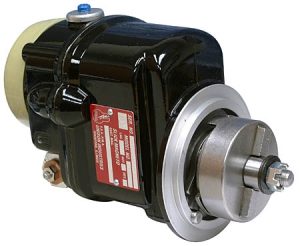So I’ve been told my airplane engine has two magnetos, but what the heck is a magneto? Well in a reciprocating airplane engine like that of Lycoming IO-360 found in many Cessna 172 aircraft the magnetos are a source of high-voltage electrical energy. This electrical energy is used to produce the spark to ignite the fuel-air mixture inside the cylinders of a reciprocating engine. They are called magnetos because they use a permanent magnet to generate the electrical current sent to the spark plugs.
Once the starter is engaged and the crank shaft begins turning, the magnetos will activate and start producing the electrical energy needed to create a spark in the cylinders. It is important to understand that the magnetos operate completely independent of the aircraft’s electrical system. This is done for safety; in the event of a complete electrical failure, the engine will not shut down.
Key point: as the crankshaft turns so do the magnets within the magnetos creating the aforementioned energy. So for the engine to initially start, some source of outside energy needs turn the crankshaft. This is most commonly done by engaging the starter within the engine which does require an initial amount of electrical energy that comes from the batteries. However, you may fly an older aircraft that does not contain a starter, as one of the aircraft engine components, in a case like this an individual would physical turn the crankshaft by hand propping the airplane (caution: hand propping is extremely dangerous, always consult the aircraft’s operating handbook and follow proper hand propping procedures).
You learned in Monday’s post that each magneto operates independently of one another and contains a 5-position ignition switch: OFF, R, L, BOTH, and START. When OFF is selected you have in turn grounded both magnetos preventing them from creating the necessary spark for engine ignition. If selecting R or L (Right or Left magneto) you are grounding only one magneto, the one which is not selected. For example, if the L is selected the right magneto is grounded. The system will operate on both magnetos when BOTH is selected. By moving the ignition switch to the START indication you will engage the aircraft engine starter and un-ground both magnetos. As in most cases, you will have to hold the switch in this position while engaging the starter, releasing the switch it will snap back into the BOTH position, as it is designed to do allowing the engine to run on the both magnetos.
So what happens if you accidentally turn the magnetos to the OFF position in-flight? Well, the engine will stop as no spark will be provided to the cylinders to create combustion. Even though the engine is stopped the propeller will likely still be windmilling due to aerodynamic forces. Because that prop is still spinning so is the crankshaft, so simply turning the ignition switch back to BOTH should allow your engine to restart without problem. Always consult the pilot operating handbook for all in-flight restart procedures as these can and will vary between aircraft. And please try not to accidentally turn your magnetos off.
Questions about the magnetos or ignition systems? Let us know in the comments section and we will do our best to answer your questions.






